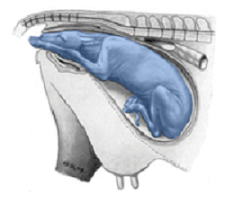Life History and Reproduction
When the first skeleton of the Good Mother Whale was found,
it was determined right away to be female. It had an intact fetal
skeleton within it which had characteristics of many sexual
reproducing mammals today. It was stated in an article that the
newborn of Maiacetus inuus was commonly related to the
newborn of fallow deer (Gingerich et al. 2009). The newborn
of Maiacetus inuus was also said to be similar to the fallow deer
because it was more developed in the womb. This is so that it would be born
more mature in order to be able to feed itself almost right after
development. This makes them similar to all the marine animals today
whose young are also developed in the womb for early feeding
independence.
There is a clear sexual dimorphism between the Maiacetus
inuus in multiple studies (Gingerich et al. 2009;
Perkins 2009). There was also another Maiacetus inuus found and
it was inferred to be a male because there was no skeletal fetus and
its skeletal structure was much larger than that of the female
(Gingerich et al. 2009). It also had common skeletal characteristics of a male (Gingerich
et al. 2009) and it is also assumed that males did not fight for the attention of a
female mate but spread out among each other through the sea.

.png)
One of the things about the female skeleton of Maiacetus inuus
that helped scientists gather the most information on the
reproduction of this organism was that there was an intact skeletal
fetus within the skeleton. The position of the fetal
skeleton says a lot about the reproduction and young of
Maiacetus inuus. The fetal skeleton was in a head-first
birthing position which, in large-bodied land mammals, is a universal
posture for birthing (Gingerich et al. 2009). This is not
normal for marine mammals that are fully aquatic. The discovery of
this lead to the explanation that semiaquatic protocetids still gave
birth on land (Gingerich et al. 2009).
Also, because the skeleton still had the fetus within it, it gave scientists enough information to figure out that Maiacetus inuus also gave birth on land. This is why they had hind limb-like structures. This allows a newborn to breath during labor (Gingerich et al. 2009). Later generations of the whale show that they slowly lost the hind limbs to support birth on land and thus started aquatic birthing.
Continue on to Interactions to continue learning about Maiacetus inuus.
